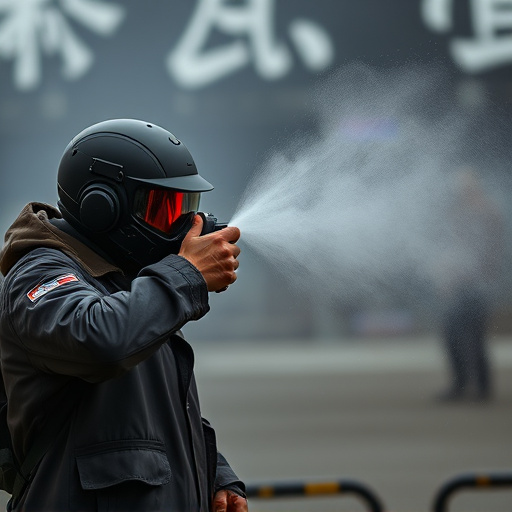Pepper spray, a non-lethal crowd control agent, uses capsaicin to cause temporary sensory irritation, not blindness. While effective for de-escalating tensions during civil unrest and self-defense, it carries risks including respiratory issues, skin irritation, and potential long-term health effects. Its use is globally contentious, with varying regulations and debates over its effectiveness and safety, particularly regarding the ability of pepper spray to blind users.
“Discover the powerful tool that is inflammatory spray, particularly pepper spray, its role in riot control, and its global impact. This article delves into the mechanics of pepper spray, exploring how it works and the associated risks, including its potential to cause temporary blindness. We examine real-world use cases in law enforcement, highlighting its effectiveness. Additionally, we provide a global perspective on usage and regulations, shedding light on the diverse approaches to managing civil unrest.”
- What is Inflammatory Spray for Riot Control?
- How Does Pepper Spray Work and Are There Risks?
- Effective Use Cases of Inflammatory Sprays in Law Enforcement
- Global Perspectives on Pepper Spray Usage and Regulations
What is Inflammatory Spray for Riot Control?
Inflammatory spray, often referred to as riot control or pepper spray, is a specialized law enforcement and military agent designed for crowd dispersion and controlling violent demonstrations. This non-lethal weapon creates a temporary yet intense sensory irritation, enabling authorities to manage and restore order in chaotic situations. The primary active ingredient in these sprays is capsaicin, the same compound responsible for the heat sensation in chili peppers, which can cause tears, coughing, and difficulty breathing when exposed.
Unlike commonly perceived, pepper spray does not necessarily aim to blind its target but rather overloads the eyes’ sensory receptors, leading to temporary blindness or reduced visibility. This disruption is crucial in de-escalating high-tension scenarios, as it gives officers and bystanders time to gain control and prevent further escalation. With its ability to quickly incapacitate individuals without causing permanent harm, inflammatory spray has become a standard tool for maintaining public safety during civil unrest and large gatherings.
How Does Pepper Spray Work and Are There Risks?
Pepper spray, a common tool in riot control and law enforcement, works by irritating the eyes, nose, throat, and respiratory system. It contains capsaicin, the same compound that gives chili peppers their heat. When sprayed, capsaicin binds to pain receptors, causing a burning sensation and temporary blindness, or at least significant visual disorientation. This disruption can help control rioters and allow for safer crowd management.
However, there are risks associated with pepper spray. While it’s rarely permanent, blindness from pepper spray can last from several seconds to over an hour, depending on the concentration and duration of exposure. Inhaling the spray can lead to severe coughing, difficulty breathing, and even panic attacks in sensitive individuals. There are also concerns about long-term health effects, including potential damage to respiratory systems for frequent or prolonged exposure. As such, the use of pepper spray should be carefully considered and restricted to situations where it’s absolutely necessary.
Effective Use Cases of Inflammatory Sprays in Law Enforcement
In the realm of law enforcement, inflammatory sprays like pepper spray have proven to be valuable tools for riot control and crowd management. One of its primary effective use cases is neutralizing aggressive individuals who pose a threat to public safety. Pepper spray isn’t designed to blind but rather to temporarily disable, allowing officers to gain control and de-escalate the situation. It’s particularly useful in high-risk environments such as protests, sporting events, and other gatherings where large crowds can quickly turn violent.
Additionally, these inflammatory sprays are instrumental in self-defense scenarios for both officers and civilians. In close-quarters confrontations, a quick deployment of pepper spray can disrupt an attacker’s balance, providing the user with precious time to escape or subdue the assailant. The non-lethal nature of such sprays makes them a preferred choice for law enforcement agencies worldwide, ensuring public safety without resorting to more lethal force.
Global Perspectives on Pepper Spray Usage and Regulations
Around the globe, the use of pepper spray for riot control is a highly debated topic with varying perspectives and regulations. While some countries embrace it as a necessary tool for law enforcement to maintain public safety during disturbances, others have strict restrictions or outright ban its use due to human rights concerns. The World Health Organization (WHO) has expressed caution regarding the potential health risks associated with pepper spray, including respiratory distress, skin irritation, and in extreme cases, temporary blindness.
In terms of regulations, many countries have specific guidelines governing the use of pepper spray. For instance, in some jurisdictions, it’s only permitted for self-defense or as a last resort when other non-lethal methods fail. There are also restrictions on the concentration of capsaicin, the active ingredient in pepper spray, to minimize severe side effects. The concern about can pepper spray blind you remains a significant point of contention, with advocates emphasizing controlled usage and opponents pushing for alternatives that pose less risk to public health and safety.
Pepper spray, while effective for riot control and law enforcement purposes, comes with risks. Its ability to temporarily disable individuals through irritation and inflammation is well-documented, but it’s crucial to understand its limitations and potential side effects, including the possibility of blinding users if not used properly. Global regulations vary widely, underscoring the need for responsible usage and ongoing research into safer alternatives. Despite these considerations, pepper spray remains a game-changer in public safety when employed strategically within established guidelines.
